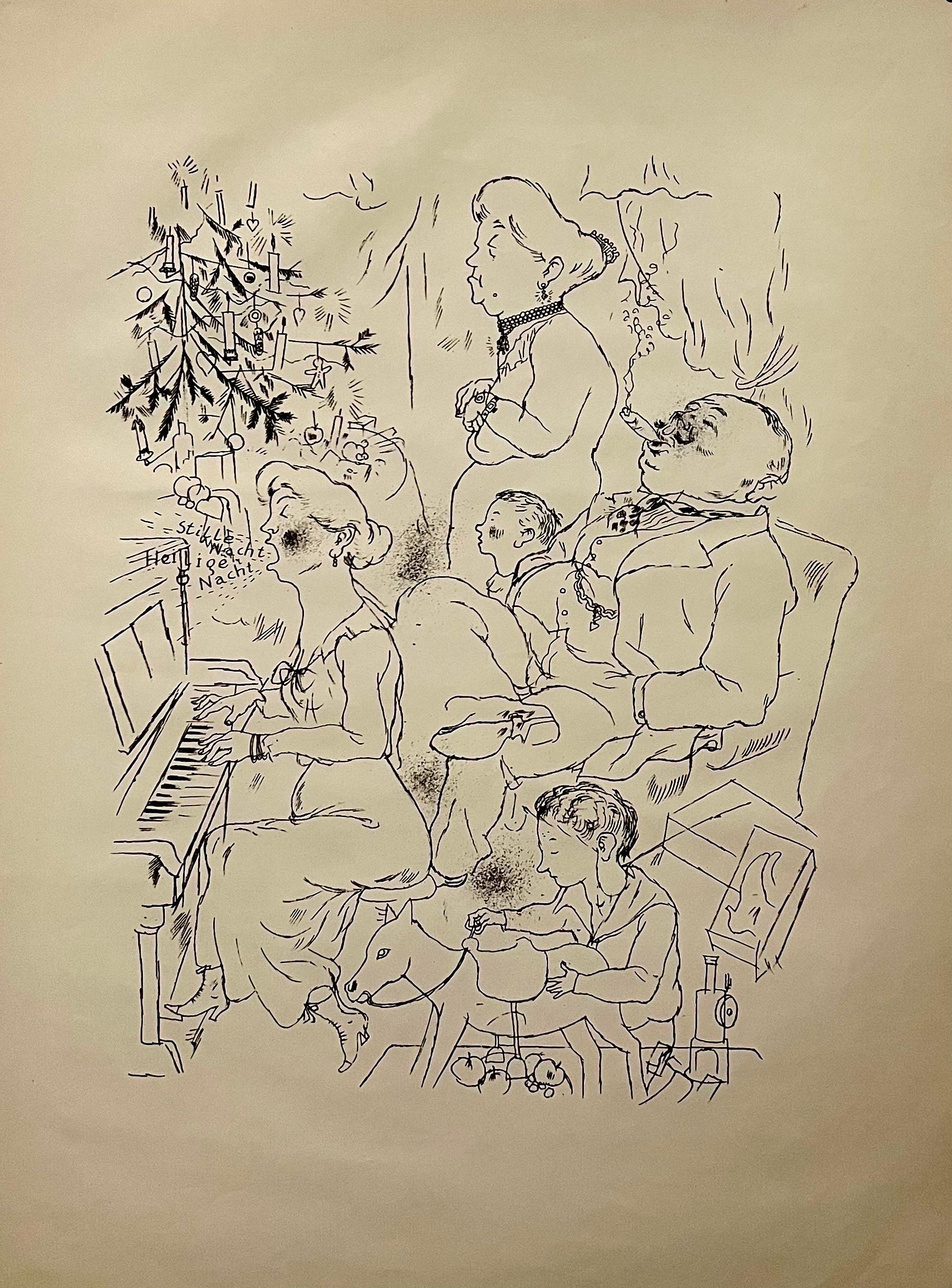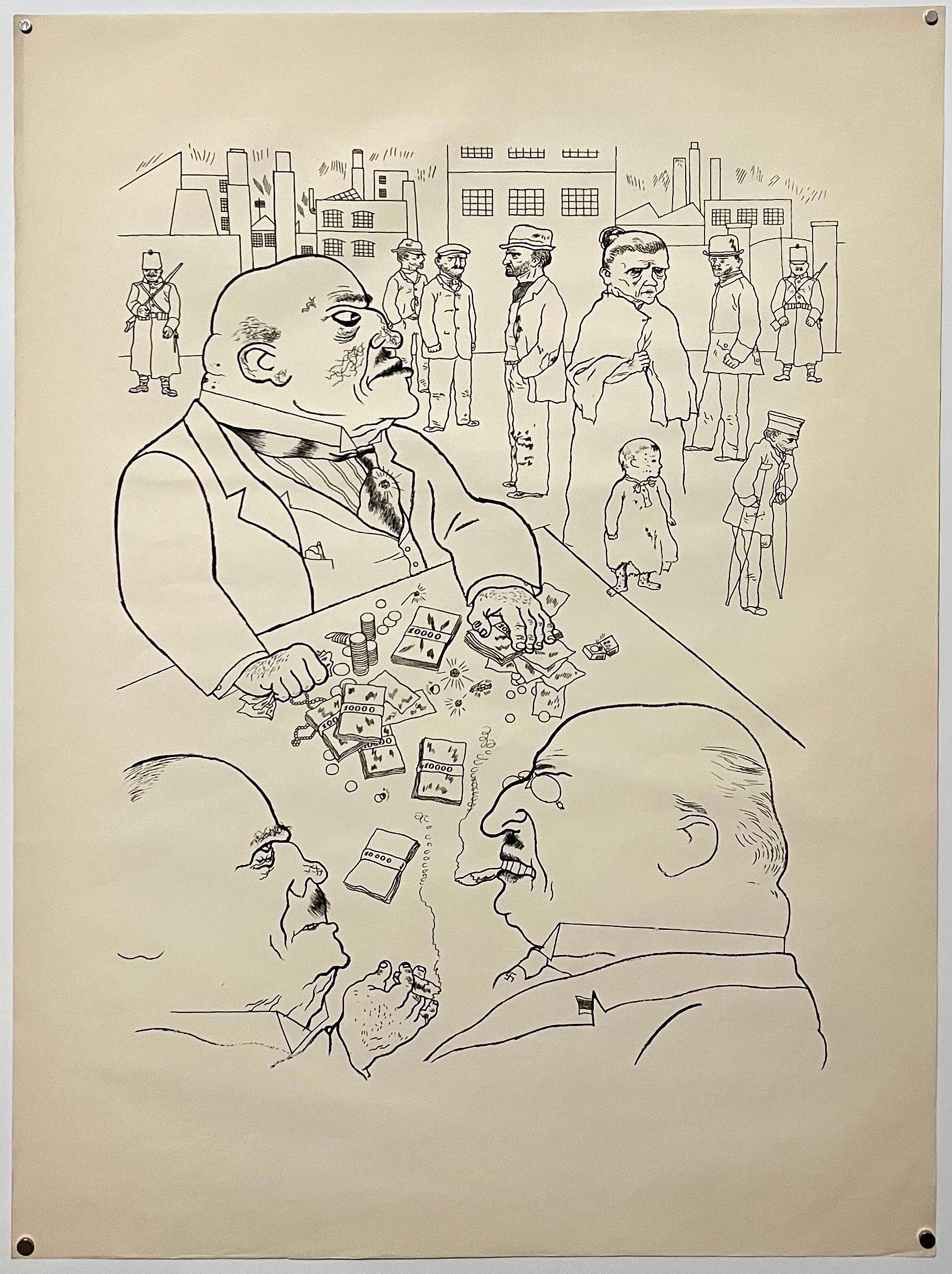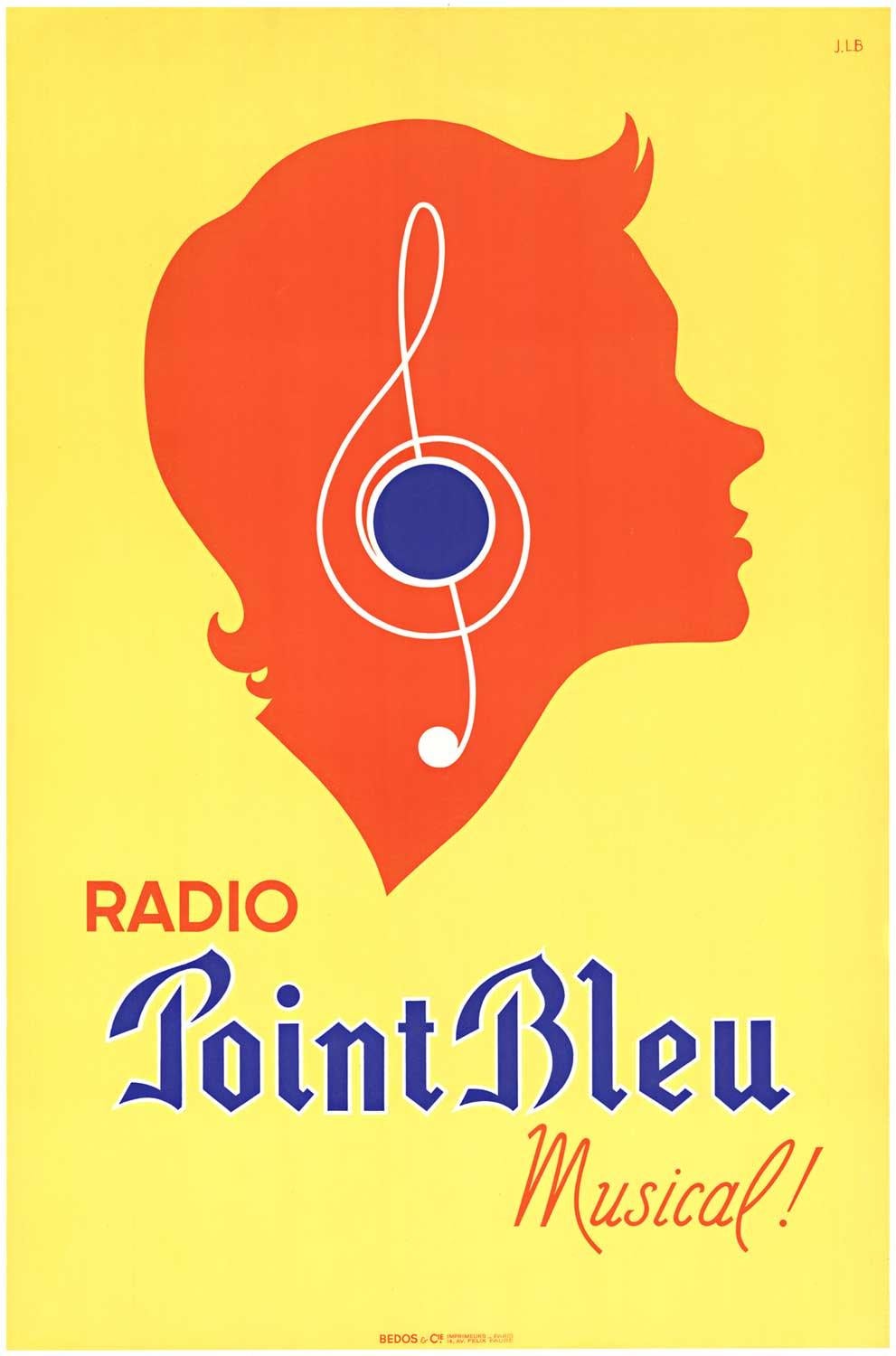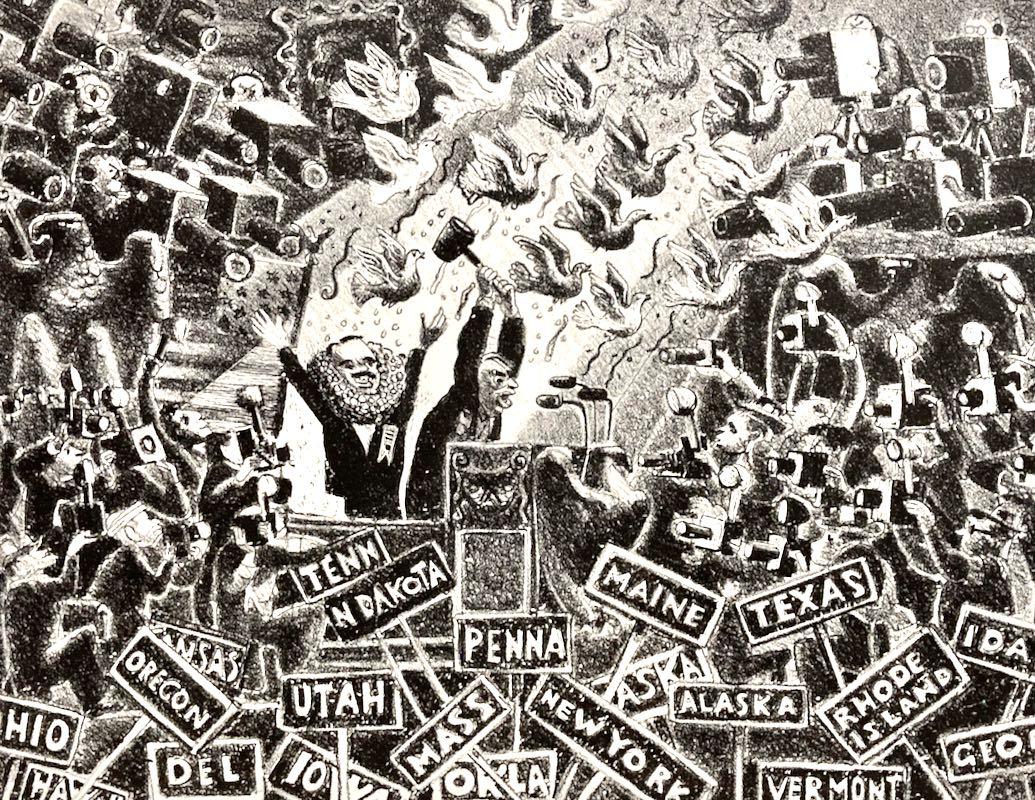George GroszLarge George Grosz 1923 Lithograph Die Rauber German Expressionism WPA Realism 1922-1923
1922-1923
About the Item
- Creator:George Grosz (1891-1969, German)
- Creation Year:1922-1923
- Dimensions:Height: 25.5 in (64.77 cm)Width: 19 in (48.26 cm)
- Medium:
- Movement & Style:
- Period:
- Condition:good, minor wear. please see photos.
- Gallery Location:Surfside, FL
- Reference Number:1stDibs: LU38212491742
George Grosz
George Grosz was a German artist known especially for his caricatural drawings and paintings of Berlin life in the 1920s. He was a prominent member of the Berlin Dada and New Objectivity group during the Weimar Republic. Grosz studied drawing at the Dresden Academy (1909–11) and at the School of Arts and Crafts in Berlin (1912–14). He was in the army from 1914–15, and again for a short time in 1917, but spent the rest of the war in Berlin, where he made violently anti-war drawings, in which his main focus was attacking the social corruption of Germany (capitalists, prostitutes, the Prussian military caste, the middle class). His artworks had great impact in the Berlin Dada movement, 1917–20, and collaborated with John Heartfield and Raoul Hausmann in the invention of photomontage.
Many of Grosz’s drawings were published in albums (Gott mit uns, Ecce Homo, Der Spiesser-Spiegel, etc.), and he was subject to prosecutions for insulting the army and blasphemy. He visited the United States in 1932 to teach at the Art Students League, New York, and settled there in 1933. In the latter part of his career, he tried to establish himself as a pure painter of landscapes and still life, but also painted many compositions of an apocalyptic and deeply pessimistic kind. His role in the Berlin Dada movement affected political outlooks and artistic developments not only in Germany, but also in Russia, the Balkan nations, and parts of France.
Grosz's penetrating, darkly humorous style of drawing and his use of satire as a weapon left a deep impression on the work of his contemporaries and the artists of the next generation. Some of his works from the early 1940s, particularly during World War II, do present an allegorical and dramatic representation of Grosz's moral perspective regarding war. Additionally, some of his last pieces from 1958 were photomontages, and hearken back to his earlier Dadaist aesthetic and message, passing judgment upon consumerism and suggesting that his absorption with American culture had ended in disappointment. In 1959, Grosz sold his house and moved back to Berlin. He died shortly after his return, after a fall down the stairs.
- ShippingRetrieving quote...Ships From: Surfside, FL
- Return PolicyA return for this item may be initiated within 3 days of delivery.
- Large George Grosz 1923 Lithograph Die Rauber German Expressionism WPA RealismBy George GroszLocated in Surfside, FLFrom The robbers. lithographs by George Grosz for the drama of the same name. photolithography on watermarked paper. 19 X 25.5 inches (sheet size). This is not hand signed or numbe...Category
1930s American Modern Figurative Prints
MaterialsLithograph
- Large George Grosz 1923 Lithograph Die Rauber German Expressionism WPA RealismBy George GroszLocated in Surfside, FLFrom The robbers. lithographs by George Grosz for the drama of the same name. photolithography on watermarked paper. 19 X 25.5 inches (sheet size). This is not hand signed or numbe...Category
1930s American Modern Figurative Prints
MaterialsLithograph
- 1970s Pop Art "Dancing Lessons #2" Silver Silkscreen Mod Ballet Girl PrintBy Joanne SeltzerLocated in Surfside, FLPrinted on a slightly reflective metallic silver finished paper. there is a companion piece on a money green paper. A depiction of a ballet dancer, superimposed upon canceled dance c...Category
1970s American Modern Portrait Prints
MaterialsScreen
- Pulitzer Prize Winner Norman Mailer Portrait Etching Line DrawingBy Knox MartinLocated in Surfside, FLSigned. Numbered line etching Norman Kingsley Mailer (January 31, 1923 – November 10, 2007) was an American novelist, journalist, essayist, playwright, film-maker, actor, and libera...Category
1970s American Modern Figurative Prints
MaterialsEtching
- Golda Meir Israeli Woman Prime Minister Smoking Cigarette Ink Line Etching PrintLocated in Surfside, FLGolda Meir, Israeli Zionist leader, Prime Minister and feminist icon, smoking a cigarette. Nancy Drosd is a painter working in New York City. Since 2001 s...Category
1970s American Modern Figurative Prints
MaterialsEtching
- Jewish Shtetl Hasidic Wedding Dance Judaica Lithograph Yiddish Social RealismBy William GropperLocated in Surfside, FLHand signed in pencil and numbered with Roman numerals 8/24. A very small edition. Old Lower East Side of New York or East European Shtetl. Jewish Shtetl Hasidic Klezmer Musicians. ...Category
Mid-20th Century Modern Figurative Prints
MaterialsLithograph
- Original "Radio Point Bleu Musical!" vintage French poster, linen backedLocated in Spokane, WAOriginal “Radio Point Bleu Musical!” vintage French antique poster. Archivail linen backed in very fine condition, ready to frame. Signed J.L.B. in the plate at upper right. No specific year is indicated on the poster. Point Bleu / Radio Musical! Paris: Bedos & Cie. Lithograph poster for the French radio manufacturer, showing a woman’s face in silhouette with a treble clef over her ear; red and blue lettering against a bright yellow background. Printer: Paris: Bedos & Cie. The poster does not have a date, but most of the Point Bleu radio posters...Category
1940s American Modern Portrait Prints
MaterialsLithograph
- Alfred Bendiner, ...And So..., 1948, Republican Convention nominating DeweyBy Alfred BendinerLocated in New York, NYThe full title really should be ...And So I Give Your The Next President of the United States. The scene is the Republican Convention, in Philadelphia, in 1948. There are so many fas...Category
Mid-20th Century American Modern Portrait Prints
MaterialsLithograph
- Chelsea RagsBy James Abbott McNeill WhistlerLocated in Storrs, CTChelsea Rags. Chelsea Rags. 1888. Lithograph. Way 22, Levy 35, Tedeschi, Stratis and Spink 26. 7 1/8 x 6 5/16 (sheet 12 3/4 x 8). Printed on cream laid paper. Provenance: Miss Rosalind Birnie Philip, Whistler's sister-in-law, her seal verso: (Lugt 405). Michael Parkin Fine Art, Ltd. from whom purchased in 1972. Christie's, King Street.Signed with the butterfly in the image. One of 13 impressions listed by Way, before the image was transferred to supplementary stones for the edition of 500-1,000 printed by Way and issued in the Albemarle, January, 1892. Signed with the butterfly in the stone and in pencil. Housed in an elegant silk mat with a silver liner, and in a 16 3/4 x 14 3/4-inch silver leaf frame decorated with fleur-de-lis decorations. "And his interest in London has not been restricted to the Thames. Seeing the beautiful, where other men might be discouraged by dullness, he has taken his subject, now in the little cheap shop opening a low window upon the street, now in the forgotten church hidden away in a lonely square. And Chelsea Rags, the Shops of Chelsea, the Drury Lane, as well as The Butcher's Dog, are impressions of vague Rembrandtesque interiors where figures, grim or graceful, peer from out deep shadows— shops as lovely in his prints as the halls of a Veronese, or the palaces of a Claude." Elizabeth Robins...Category
Late 19th Century American Modern Figurative Prints
MaterialsLithograph
- Selected Tales of Guy de Maupassant, the complete portfolioBy Adolf DehnLocated in Middletown, NYTwenty hand-signed, numbered, and titled images based on the selected work of Maupsassant. Portfolio containing 20 lithographs based on selected tales by de Maupassant, printed on h...Category
Mid-20th Century American Modern Portrait Prints
MaterialsHandmade Paper, Lithograph
- Original Holiday Come to Belgium by Dover Ostend vintage travel posterLocated in Spokane, WAOriginal Holiday, Come to Belgium vy Dover Ostend vintage travel poster. Conservation linen backed in A condition ready to frame. Printer: Cocu & Mairesse, Quaregnon. An adorable cherub invites us to hop on the ferry from Dover to holiday in Belgium. At just three hours of travel time, it’s a quick and easy way to cross the English Channel. A halo with the wording Holiday rests on her head, where white wings allow her to float in the air with her set of golf clubs and to hold onto her luggage. Come to Belgium by Dover Ostend ferry. The sky is a baby blue, and her dress is dark blue. She is looking back as she flies along. You can see that her feet appear to be backward as she starts to land, but this is because she has turned her head to look back, maybe to make sure her wings are fully extended for the journey. This is an Original Lithograph Vintage Poster...Category
1950s American Modern Figurative Prints
MaterialsLithograph
- Time After Time.By Ann ChernowLocated in Storrs, CTLithograph with watercolor. 22 3/8 x 30 5/8. Edition 56 (plus 5 artist's proofs). A bright impression printed on the full sheet of Arches paper. Signed and numbered 4/56 in pencil. ...Category
Late 20th Century American Modern Figurative Prints
MaterialsWatercolor, Color, Lithograph






